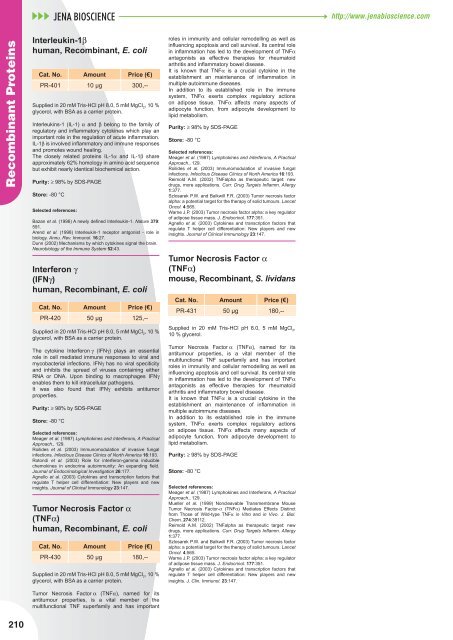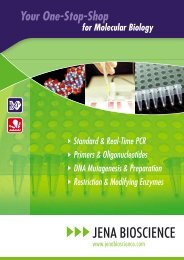Nucleotide Analogs - Jena Bioscience
Nucleotide Analogs - Jena Bioscience
Nucleotide Analogs - Jena Bioscience
You also want an ePaper? Increase the reach of your titles
YUMPU automatically turns print PDFs into web optimized ePapers that Google loves.
Recombinant Proteins<br />
210<br />
Interleukin-1β<br />
human, Recombinant, E. coli<br />
Cat. No. Amount Price (€)<br />
PR-401 10 µg 300,--<br />
Supplied in 20 mM Tris-HCl pH 8.0, 5 mM MgCl 2 , 10 %<br />
glycerol, with BSA as a carrier protein.<br />
Interleukins-1 (IL-1) α and β belong to the family of<br />
regulatory and infl ammatory cytokines which play an<br />
important role in the regulation of acute infl ammation.<br />
IL-1β is involved infl ammatory and immune responses<br />
and promotes wound healing.<br />
The closely related proteins IL-1α and IL-1β share<br />
approximately 62% homology in amino acid sequence<br />
but exhibit nearly identical biochemical action.<br />
Purity: ≥ 98% by SDS-PAGE<br />
Store: -80 °C<br />
Selected references:<br />
Bazan et al. (1996) A newly defi ned Interleukin-1. Nature 379:<br />
591.<br />
Arend et al. (1998) Interleukin-1 receptor antgonist - role in<br />
biology. Annu. Rev. Immunol. 16:27.<br />
Dunn (2002) Mechanisms by which cytokines signal the brain.<br />
Neurobiology of the Immune System 52:43.<br />
Interferon γ<br />
(IFNγ)<br />
human, Recombinant, E. coli<br />
Cat. No. Amount Price (€)<br />
PR-420 50 µg 125,--<br />
Supplied in 20 mM Tris-HCl pH 8.0, 5 mM MgCl 2 , 10 %<br />
glycerol, with BSA as a carrier protein.<br />
The cytokine Interferon γ (IFNγ) plays an essential<br />
role in cell mediated immune responses to viral and<br />
mycobacterial infections. IFNγ has no viral speciticity<br />
and inhibits the spread of viruses containing either<br />
RNA or DNA. Upon binding to macrophages IFNγ<br />
enables them to kill intracellular pathogens.<br />
It was also found that IFNγ exhibits antitumor<br />
properties.<br />
Purity: ≥ 98% by SDS-PAGE<br />
Store: -80 °C<br />
Selected references:<br />
Meager et al. (1987) Lymphokines and Interferons, A Practical<br />
Approach., 129.<br />
Roilides et al. (2003) Immunomodulation of invasive fungal<br />
infections. Infectious Disease Clinics of North America 16:193.<br />
Rotondi et al. (2003) Role for interferon-gamma inducible<br />
chemokines in endocrine autoimmunity: An expanding fi eld.<br />
Journal of Endocrinological Investigation 26:177.<br />
Agnello et al. (2003) Cytokines and transcription factors that<br />
regulate T helper cell differentiation: New players and new<br />
insights. Journal of Clinical Immunology 23:147.<br />
Tumor Necrosis Factor α<br />
(TNFα)<br />
human, Recombinant, E. coli<br />
Cat. No. Amount Price (€)<br />
PR-430 50 µg 180,--<br />
Supplied in 20 mM Tris-HCl pH 8.0, 5 mM MgCl 2 , 10 %<br />
glycerol, with BSA as a carrier protein.<br />
Tumor Necrosis Factor α (TNFα), named for its<br />
antitumour properties, is a vital member of the<br />
multifunctional TNF superfamily and has important<br />
roles in immunity and cellular remodelling as well as<br />
infl uencing apoptosis and cell survival. Its central role<br />
in infl ammation has led to the development of TNFα<br />
antagonists as effective therapies for rheumatoid<br />
arthritis and infl ammatory bowel disease.<br />
It is known that TNFα is a crucial cytokine in the<br />
establishment an maintenance of infl ammation in<br />
multiple autoimmune diseases.<br />
In addition to its established role in the immune<br />
system, TNFα exerts complex regulatory actions<br />
on adipose tissue. TNFα affects many aspects of<br />
adipocyte function, from adipocyte development to<br />
lipid metabolism.<br />
Purity: ≥ 98% by SDS-PAGE<br />
Store: -80 °C<br />
Selected references:<br />
Meager et al. (1987) Lymphokines and Interferons, A Practical<br />
Approach., 129.<br />
Roilides et al. (2003) Immunomodulation of invasive fungal<br />
infections. Infectious Disease Clinics of North America 16:193.<br />
Reimold A.M. (2002) TNFalpha as therapeutic target: new<br />
drugs, more applications. Curr. Drug Targets Infl amm. Allergy<br />
1:377.<br />
Szlosarek P.W. and Balkwill F.R. (2003) Tumor necrosis factor<br />
alpha: a potential target for the therapy of solid tumours. Lancet<br />
Oncol. 4:565.<br />
Warne J.P. (2003) Tumor necrosis factor alpha: a key regulator<br />
of adipose tissue mass. J. Endocrinol. 177:351.<br />
Agnello et al. (2003) Cytokines and transcription factors that<br />
regulate T helper cell differentiation: New players and new<br />
insights. Journal of Clinical Immunology 23:147.<br />
Tumor Necrosis Factor α<br />
(TNFα)<br />
mouse, Recombinant, S. lividans<br />
Cat. No. Amount Price (€)<br />
PR-431 50 µg 180,--<br />
Supplied in 20 mM Tris-HCl pH 8.0, 5 mM MgCl 2,<br />
10 % glycerol.<br />
Tumor Necrosis Factor α (TNFα), named for its<br />
antitumour properties, is a vital member of the<br />
multifunctional TNF superfamily and has important<br />
roles in immunity and cellular remodelling as well as<br />
infl uencing apoptosis and cell survival. Its central role<br />
in infl ammation has led to the development of TNFα<br />
antagonists as effective therapies for rheumatoid<br />
arthritis and infl ammatory bowel disease.<br />
It is known that TNFα is a crucial cytokine in the<br />
establishment an maintenance of infl ammation in<br />
multiple autoimmune diseases.<br />
In addition to its established role in the immune<br />
system, TNFα exerts complex regulatory actions<br />
on adipose tissue. TNFα affects many aspects of<br />
adipocyte function, from adipocyte development to<br />
lipid metabolism.<br />
Purity: ≥ 98% by SDS-PAGE<br />
Store: -80 °C<br />
Selected references:<br />
Meager et al. (1987) Lymphokines and Interferons, A Practical<br />
Approach., 129.<br />
Mueller et al. (1999) Noncleavable Transmembrane Mouse<br />
Tumor Necrosis Factor-α (TNFα) Mediates Effects Distinct<br />
from Those of Wild-type TNFα in Vitro and in Vivo. J. Biol.<br />
Chem..274:38112.<br />
Reimold A.M. (2002) TNFalpha as therapeutic target: new<br />
drugs, more applications. Curr. Drug Targets Infl amm. Allergy<br />
1:377.<br />
Szlosarek P.W. and Balkwill F.R. (2003) Tumor necrosis factor<br />
alpha: a potential target for the therapy of solid tumours. Lancet<br />
Oncol. 4:565.<br />
Warne J.P. (2003) Tumor necrosis factor alpha: a key regulator<br />
of adipose tissue mass. J. Endocrinol. 177:351.<br />
Agnello et al. (2003) Cytokines and transcription factors that<br />
regulate T helper cell differentiation: New players and new<br />
insights. J. Clin. Immunol. 23:147.<br />
http://www.jenabioscience.com



